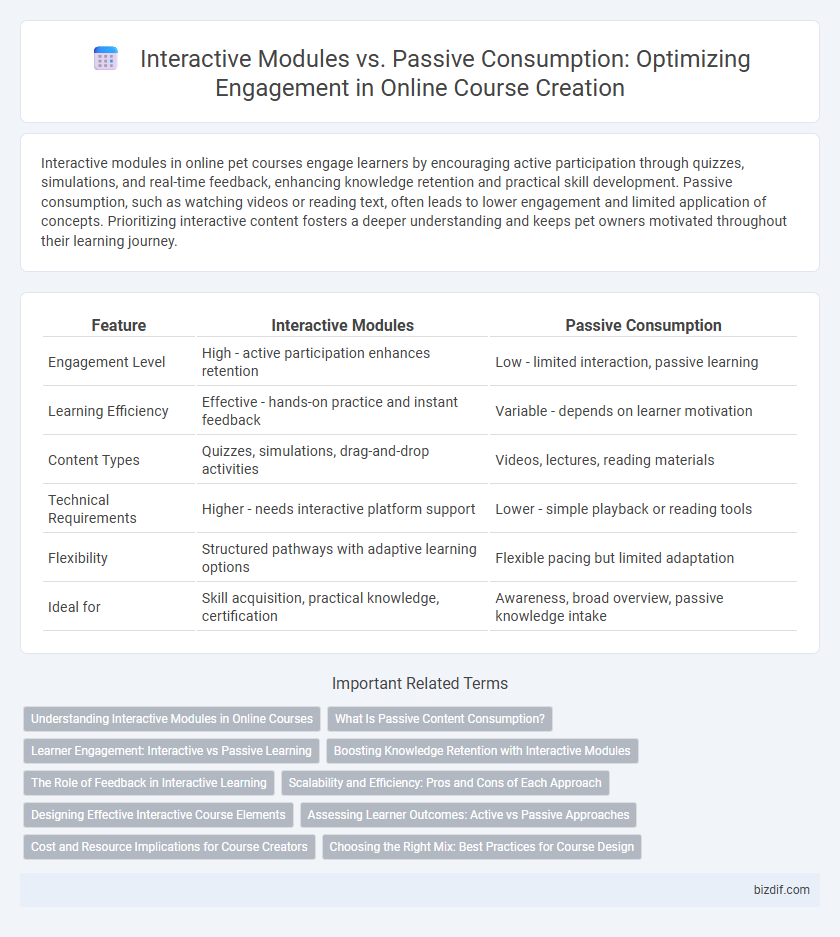Interactive modules in online pet courses engage learners by encouraging active participation through quizzes, simulations, and real-time feedback, enhancing knowledge retention and practical skill development. Passive consumption, such as watching videos or reading text, often leads to lower engagement and limited application of concepts. Prioritizing interactive content fosters a deeper understanding and keeps pet owners motivated throughout their learning journey.
Table of Comparison
| Feature | Interactive Modules | Passive Consumption |
|---|---|---|
| Engagement Level | High - active participation enhances retention | Low - limited interaction, passive learning |
| Learning Efficiency | Effective - hands-on practice and instant feedback | Variable - depends on learner motivation |
| Content Types | Quizzes, simulations, drag-and-drop activities | Videos, lectures, reading materials |
| Technical Requirements | Higher - needs interactive platform support | Lower - simple playback or reading tools |
| Flexibility | Structured pathways with adaptive learning options | Flexible pacing but limited adaptation |
| Ideal for | Skill acquisition, practical knowledge, certification | Awareness, broad overview, passive knowledge intake |
Understanding Interactive Modules in Online Courses
Interactive modules in online courses enhance learner engagement by incorporating quizzes, simulations, and real-time feedback, promoting active participation rather than passive consumption. These modules improve knowledge retention and critical thinking by allowing learners to apply concepts in practical scenarios. Research indicates that interactive content increases course completion rates and learner satisfaction compared to traditional video lectures or readings.
What Is Passive Content Consumption?
Passive content consumption involves learners receiving information without actively engaging, such as watching videos or reading texts without interaction. This learning style limits retention and critical thinking, as it does not encourage learners to apply or test knowledge. Effective online course creation encourages shifting from passive content consumption to interactive modules that boost engagement and comprehension.
Learner Engagement: Interactive vs Passive Learning
Interactive modules significantly boost learner engagement by promoting active participation through quizzes, simulations, and real-time feedback, which enhances knowledge retention and critical thinking skills. In contrast, passive consumption methods like video lectures or reading materials often lead to lower attention spans and reduced information absorption. Fostering interactive learning environments increases motivation and leads to better educational outcomes in online course creation.
Boosting Knowledge Retention with Interactive Modules
Interactive modules significantly enhance knowledge retention by actively engaging learners through quizzes, simulations, and real-time feedback, which stimulates deeper cognitive processing. Passive consumption, such as watching videos or reading text, often leads to lower retention as it encourages surface-level engagement without practical application. Integrating interactive elements within online courses fosters long-term memory retention and improves user motivation compared to passive learning methods.
The Role of Feedback in Interactive Learning
Interactive modules enhance online course creation by incorporating real-time feedback, enabling learners to actively engage with content and correct mistakes instantly. This dynamic exchange boosts knowledge retention and fosters deeper understanding compared to passive consumption, where learners merely absorb information without interaction. Effective feedback mechanisms in interactive learning environments promote skill mastery and sustained motivation, driving improved educational outcomes.
Scalability and Efficiency: Pros and Cons of Each Approach
Interactive modules enhance learner engagement and retention through active participation, making them scalable with the right technology but often requiring higher upfront costs and development time. Passive consumption supports rapid content dissemination and lower production expenses, enabling efficient scalability for large audiences but may result in reduced learner interaction and retention. Balancing scalability and efficiency depends on course objectives, budget, and target audience engagement levels.
Designing Effective Interactive Course Elements
Designing effective interactive course elements enhances learner engagement by incorporating quizzes, simulations, and real-time feedback, promoting active participation rather than passive consumption. Interactive modules improve knowledge retention and encourage critical thinking through hands-on activities tailored to diverse learning styles. By leveraging multimedia tools, educators create dynamic experiences that foster deeper understanding and sustained motivation in online course environments.
Assessing Learner Outcomes: Active vs Passive Approaches
Interactive modules engage learners through hands-on activities and real-time feedback, significantly enhancing knowledge retention and skill application compared to passive consumption methods. Assessing learner outcomes in active approaches involves dynamic tools such as quizzes, simulations, and scenario-based tasks that measure comprehension and critical thinking effectively. Passive consumption, relying primarily on video lectures or reading materials, often results in lower engagement and weaker evidence of mastery, highlighting the importance of interactivity in online course design.
Cost and Resource Implications for Course Creators
Interactive modules often require higher upfront investments in technology, design, and development compared to passive consumption formats such as video lectures or PDFs. Course creators must allocate significant resources for software tools, skilled instructional designers, and ongoing maintenance to ensure engagement and functionality. Despite the increased cost, interactive modules can enhance learner retention and satisfaction, potentially leading to better course completion rates and long-term value.
Choosing the Right Mix: Best Practices for Course Design
In online course creation, balancing interactive modules with passive content enhances learner engagement and knowledge retention. Incorporate quizzes, discussions, and simulations to foster active participation while using videos and readings for foundational understanding. Employ analytics to assess module effectiveness and adjust the mix based on learner feedback and performance data.
Interactive modules vs Passive consumption Infographic

 bizdif.com
bizdif.com